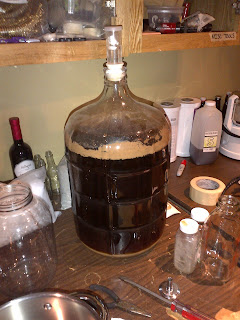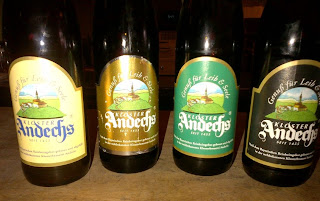 |
| Mava Roka 7% kombucha ale. |
 Interview with Sprio of Beyond Kombucha podcast
Interview with Sprio of Beyond Kombucha podcast
Until recently we associated the word "kombucha" with "health food". But our concept of this mysterious beverage was altered and our interest was considerably piqued after we were introduced to the Mava Roka, made by Beyond Kombucha. It's a 7% ABV "Maple Vanilla Rooibos Kombucha Ale" regularly on draught at the Queens Kickshaw. On first taste we knew that it had much more in common with lambic beer than anything like wheat grass juice!
 |
| 1-barrel system. |
You may be wondering, "what exactly is kombucha, and what does it have to do with beer?" For the detailed history and an in depth explanation, you can refer to the very informative What Is Kombucha? page at Beyond's website. It's also addressed in the podcast. But, in short, kombucha is a raw, fermented, probiotic, and naturally carbonated tea. Like lambic beer, the beverage is fermented by different strains of yeasts and bacterias. It has been brewed in China since at least 220 BCE. Most kombuchas are very low in alcohol (.5% to 1.5% ABV), and are touted for their health benefits.

We
spoke to Spiro Theofilatos, the founder and brewer of Beyond Kombucha,
about his brewery. He started brewing in Astoria, near Steinway and Broadway, in 2010, and no less
than two days after founding the company the federal government made an
industry-shaking decision that would dramatically affect his business
plans. The government decided that it would treat kombucha makers who
brewed beverages with more than .5% ABV -- one half of one percent --
the same as brewers of beer. The choice was either to change his
carefully constructed recipe, which created a beverage of .8% ABV, or get a
brewer's license. Spiro went all in, got licensed, and, according to
the QEDC and the Greater Astoria Historical Society, became the first brewery in Queens since Prohibition!

Obtaining
the brewer's license allowed Spiro to, indeed, go beyond kombucha. He
devised a recipe for a guten-free, sorghum malt based, 7% ABV, naturally carbonated beer. He named it Mava Roka. The beer has a dedicated line at The Queens Kickshaw, and it drinks more like a sorghum lambic than anything else! The name is an abbreviation of its ingredients:
MAple syrup, VAnilla, ROoibos tea KombuchA.

Its creation begins with a finished kombucha, which is used in place of water in the mashtun
and for sparging. The beer is made from high quality sorgham extract provided by Briess Malting, vanilla, organic maple syrup from upstate N.Y. and
three varieties of hops -- Challenger, Legacy and Cascade. Obviously,
the probiotic aspect of the brew is eliminated after boiling the wort, but all the wonderful qualities of the kombucha -- such as the sour flavors -- are
imparted to the beer. It is by far and away the best tasting sorghum
beer we've ever had (and we generally have an immense dislike of sorghum
beers).
 |
| B,R., Spiro, and Bob. |
Spiro
is working on a few new all-grain kombucha ales, including one
called Y.P.A., an I.P.A. inspired bitter pale ale using his Yerba Mate
kombucha in the brew. He's also soon to release his Lovers Saison, which uses
his Love Potion kombucha, and is brewed with Belgian aromatic malt,
Santium hops, New York City honey, and nine different aphrodisiacal
herbs.
Some noted breweries to have experimented with kombucha include Goose Island, which makes a Belgian Style pale ale called Fleur, brewed with hibiscus and kombucha tea, and Dogfish Head, which brewed Fungus Tea’Mungus for the one of the Beer Advocate Extreme Beer Fests.
 There are a few other American kombucha-beer brewers include Unity Vibration (Michigan), Deane's Kombucha (Minn.), Invisible Alchemy (Oregon), and CommuniiTea (Washington).
There are a few other American kombucha-beer brewers include Unity Vibration (Michigan), Deane's Kombucha (Minn.), Invisible Alchemy (Oregon), and CommuniiTea (Washington).
 |
| Inside an oak fermenting barrel. |
Beyond
Kombucha operates a one-barrel brewhouse, for brewing both the kombucha and
ales, using electric heating elements in the brew kettles. Spiro
considers himself a staunch environmentalist, and his brewery operates
on 100% solar energy, provided by photo-electric solar panels on the
brewery's roof. He said that even when his brewery is operating at it's
peak level of energy consumption, he's generating surplus electricity
which is sold back to the grid!
 |
| Small batch fermenting. |
Beyond Kombucha is available on a limited basis in bottles, and also on tap at places in New York like Pure Food and Wine, the Todd English bar Olives in the W hotel, The Queens Kickshaw, Eastwood, The Strand, Colicchio and Sons, Tandam Bar, and This And That.

 |
| 60-gallon barrels. |
 |
| 5-gallon test casks. |
 |
| Sixtels of Mava Roka. |
 |
| Soon to be released kombucha saison. |

 |
| Inconspicuous entrance to Beyond. |
 |
| Sixty gallon barrel. |
 |
| Delivery truck. |
 |
| Warehousing room. |
 |
| Straight up kombucha products. |


[link to podcast page]






























































